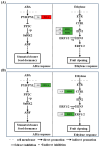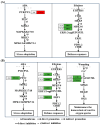Acetoin Promotes Plant Growth and Alleviates Saline Stress by Activating Metabolic Pathways in Lettuce Seedlings
- PMID: 39683105
- PMCID: PMC11644064
- DOI: 10.3390/plants13233312
Acetoin Promotes Plant Growth and Alleviates Saline Stress by Activating Metabolic Pathways in Lettuce Seedlings
Abstract
Acetoin is a volatile organic compound, which is a class of metabolites produced by plant growth-promoting rhizobacteria. The mechanisms underlying plant growth promotion by acetoin and its potential to induce saline stress tolerance in plants are poorly understood. Lettuce (Lactuca sativa L. var. ramosa Hort.) seedlings in hydronics and pots under non-saline or saline conditions were foliar-sprayed with 10 mL of 0 or 1 mg·mL-1 acetoin at 7 and 14 d after transplantation and harvested 7 d after the second spray. Shoots and roots of hydroponic lettuce seedlings were harvested at 6 and 24 h after treatment for RNA sequencing. Seedlings sprayed with acetoin showed more vigorous growth, with higher shoot and root biomass than those of the controls, in both hydronic and pot modes. The transcriptomic analysis revealed acetoin application resulted in 177 differentially expressed genes (39 upregulated and 138 downregulated) in shoots and 397 differentially expressed genes (112 upregulated and 285 downregulated) in roots. These DEGs, mainly involved in plant hormone signal transduction and the mitogen-activated protein kinase, have the potential to trigger plants' responses to various environmental stimuli, including stress and developmental signals. Under saline conditions, acetoin-treated plants showed increased net leaf photosynthesis and activities of several defense enzymes, indicating that acetoin enhances both fundamental growth and the plant's stress defenses, especially against salinity. In summary, acetoin appears to act through a complex interplay of genetic and biochemical mechanisms, influencing key signaling pathways and physiological processes that lead to improved growth and stress tolerance in lettuce seedlings.
Keywords: bio-fertilizer; photosynthesis; saline stress; transcriptome; volatile organic compounds.
Conflict of interest statement
The authors declare no conflicts of interest.
Figures










Similar articles
-
Phenotypic, Physiological, and Transcriptomic Analyses Reveal Different Responses to Salt Stress in Cultivated Red Lettuce and Wild Lettuce Seedlings.Int J Mol Sci. 2025 Apr 6;26(7):3425. doi: 10.3390/ijms26073425. Int J Mol Sci. 2025. PMID: 40244249 Free PMC article.
-
Growth promotion of Lactuca sativa in response to volatile organic compounds emitted from diverse bacterial species.Microbiol Res. 2016 Dec;193:39-47. doi: 10.1016/j.micres.2016.09.008. Epub 2016 Sep 27. Microbiol Res. 2016. PMID: 27825485
-
Exogenous foliar application of fulvic acid alleviate cadmium toxicity in lettuce (Lactuca sativa L.).Ecotoxicol Environ Saf. 2019 Jan 15;167:10-19. doi: 10.1016/j.ecoenv.2018.08.064. Epub 2018 Oct 4. Ecotoxicol Environ Saf. 2019. PMID: 30292971
-
Cadmium-accumulator straw application alleviates cadmium stress of lettuce (Lactuca sativa) by promoting photosynthetic activity and antioxidative enzyme activities.Environ Sci Pollut Res Int. 2018 Oct;25(30):30671-30679. doi: 10.1007/s11356-018-2822-4. Epub 2018 Sep 3. Environ Sci Pollut Res Int. 2018. PMID: 30178407
-
Microbial volatiles as plant growth inducers.Microbiol Res. 2018 Mar;208:63-75. doi: 10.1016/j.micres.2018.01.002. Epub 2018 Jan 31. Microbiol Res. 2018. PMID: 29551213 Review.
References
-
- Zainuddin N., Keni M.F., Ibrahim S.A.S., Masri M.M.M. Effect of integrated biofertilizers with chemical fertilizers on the oil palm growth and soil microbial diversity. Biocatal. Agric. Biotechnol. 2022;39:102237. doi: 10.1016/j.bcab.2021.102237. - DOI
-
- Shen W.S., Hu M.C., Qian D., Xue H.W., Gao N., Lin X.G. Microbial deterioration and restoration in greenhouse-based intensive vegetable production systems. Plant Soil. 2021;463:1–18. doi: 10.1007/s11104-021-04933-w. - DOI
-
- Thessalia T., Ioannis I. Effects of sand dune, desert and field arbuscular mycorrhizae on lettuce (Lactuca sativa, L.) growth in a natural saline soil. Sci. Hortic.-Amst. 2020;264:109191. doi: 10.1016/j.scienta.2020.109191. - DOI
-
- Santander C., Aroca R., Cartes P., Vidal G., Cornejo P. Aquaporins and cation transporters are differentially regulated by two arbuscular mycorrhizal fungi strains in lettuce cultivars growing under salinity conditions. Plant Physiol. Biochem. 2021;158:396–409. doi: 10.1016/j.plaphy.2020.11.025. - DOI - PubMed
Grants and funding
LinkOut - more resources
Full Text Sources

